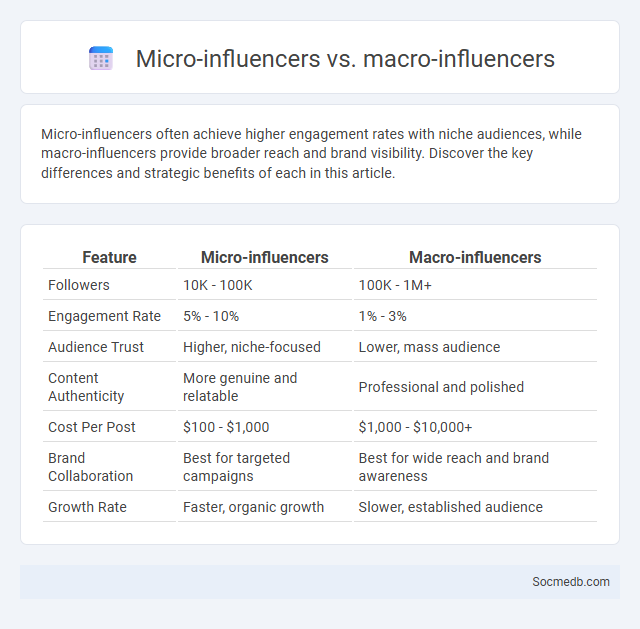
Photo illustration: Micro-influencers vs Macro-influencers
Micro-influencers often achieve higher engagement rates with niche audiences, while macro-influencers provide broader reach and brand visibility. Discover the key differences and strategic benefits of each in this article.
Table of Comparison
| Feature | Micro-influencers | Macro-influencers |
|---|---|---|
| Followers | 10K - 100K | 100K - 1M+ |
| Engagement Rate | 5% - 10% | 1% - 3% |
| Audience Trust | Higher, niche-focused | Lower, mass audience |
| Content Authenticity | More genuine and relatable | Professional and polished |
| Cost Per Post | $100 - $1,000 | $1,000 - $10,000+ |
| Brand Collaboration | Best for targeted campaigns | Best for wide reach and brand awareness |
| Growth Rate | Faster, organic growth | Slower, established audience |
Introduction to Social Media Influencer Types
Social media influencers are categorized into various types based on their follower count and niche, including mega-influencers, macro-influencers, micro-influencers, and nano-influencers. Mega-influencers typically have over a million followers and often include celebrities, while micro-influencers usually possess 10,000 to 100,000 followers with niche audiences. These distinct categories allow brands to target campaigns effectively by aligning influencer reach and engagement with specific marketing goals.
Defining Micro-Influencers: Characteristics and Reach
Micro-influencers typically have between 1,000 and 100,000 followers, enabling them to maintain high engagement rates and authentic connections with their audience. Their specialized niche focus attracts dedicated communities, making them valuable for targeted marketing campaigns. Brands leverage micro-influencers to increase trust and conversion rates due to their perceived authenticity and relatability.
Macro-Influencers Explained: Audience and Influence
Macro-influencers typically have between 100,000 to 1 million followers on social media platforms, offering a blend of broad reach and targeted engagement. Their audience spans multiple demographics, making their influence valuable for campaigns aiming to balance scale and authenticity. You can leverage macro-influencers to amplify brand awareness while maintaining a level of personal connection with followers.
Understanding Virality: What Makes Content Go Viral
Virality on social media is driven by content that evokes strong emotions, such as humor, awe, or surprise, which encourages users to share instantly. Platforms like TikTok and Instagram use algorithmic boosts that favor content with high engagement rates, amplifying reach exponentially. Understanding audience behavior and leveraging trending topics, relatable storytelling, and visual appeal significantly increase the chances of content going viral.
Key Differences: Micro vs Macro-Influencers vs Virality
Micro-influencers typically have 10K to 100K followers, offering higher engagement rates and niche audience trust, while macro-influencers reach 500K to millions with broader appeal but lower personalized interaction. Virality occurs when content rapidly spreads across platforms regardless of follower count, driven by shareability and emotional impact rather than influencer size. Brands leverage micro-influencers for targeted campaigns, macro-influencers for mass awareness, and viral content to achieve exponential organic reach.
Engagement Rates: Micro-Influencers vs Macro-Influencers
Micro-influencers consistently achieve higher engagement rates, often ranging between 5-10%, compared to macro-influencers who typically see rates around 1-3%. This difference is attributed to micro-influencers' stronger, more authentic connections with niche audiences, resulting in increased likes, comments, and shares. Brands targeting specific demographics benefit from leveraging micro-influencers to maximize audience interaction and campaign effectiveness.
Brand Collaboration Strategies: Choosing the Right Influencer
Selecting the right influencer for your brand collaboration significantly impacts engagement and conversion rates. Analyze influencers' audience demographics, content style, and authenticity to ensure alignment with your brand's values and marketing goals. Your choice should prioritize genuine connections to enhance trust and boost brand visibility on social media platforms.
Cost-Effectiveness and ROI Comparison
Social media marketing offers a highly cost-effective solution by enabling precise audience targeting and low-cost content distribution compared to traditional advertising channels. Your ROI improves through measurable metrics such as engagement rates, click-through rates, and conversion tracking, allowing continuous optimization of campaigns for maximum impact. Brands leveraging social media analytics gain a competitive edge by efficiently allocating budgets toward strategies that deliver the highest returns.
Case Studies: Successful Campaigns with Each Approach
Case studies of successful social media campaigns demonstrate the power of targeted content strategies, influencer partnerships, and interactive engagement techniques. Brands like Nike leveraged user-generated content to boost authenticity, while Coca-Cola's emotional storytelling in video campaigns increased global reach and engagement significantly. Your ability to analyze these examples can inspire tailored approaches that maximize impact and drive measurable results.
Future Trends in Influencer Marketing and Viral Content
Future trends in influencer marketing highlight a shift towards micro and nano influencers who deliver higher engagement rates and authentic connections with niche audiences, enhancing your brand's credibility. Viral content increasingly leverages AI-driven analytics to predict and shape trends, maximizing shareability and real-time audience targeting across platforms. Brands integrating immersive experiences like AR filters and interactive stories will stay ahead by fostering deeper user interaction and sustained viral momentum.
 socmedb.com
socmedb.com